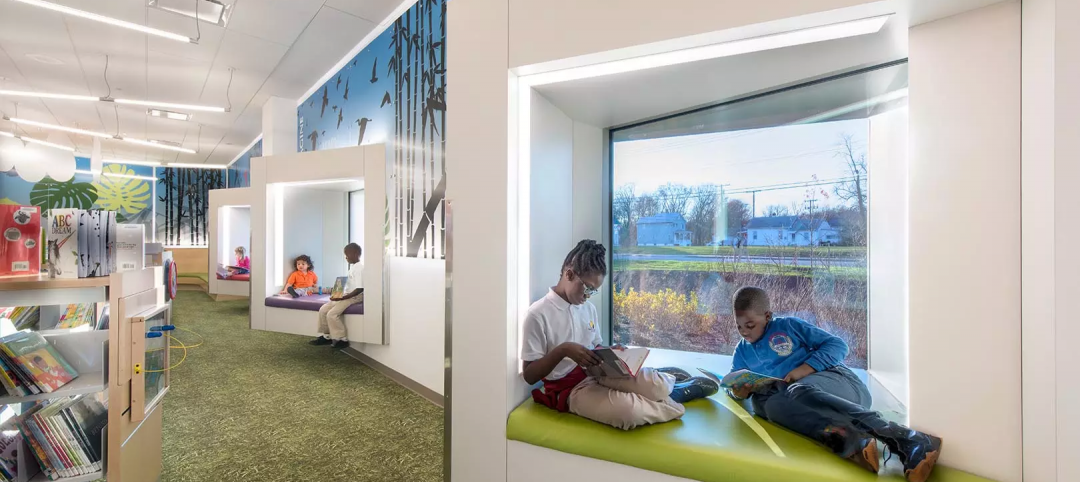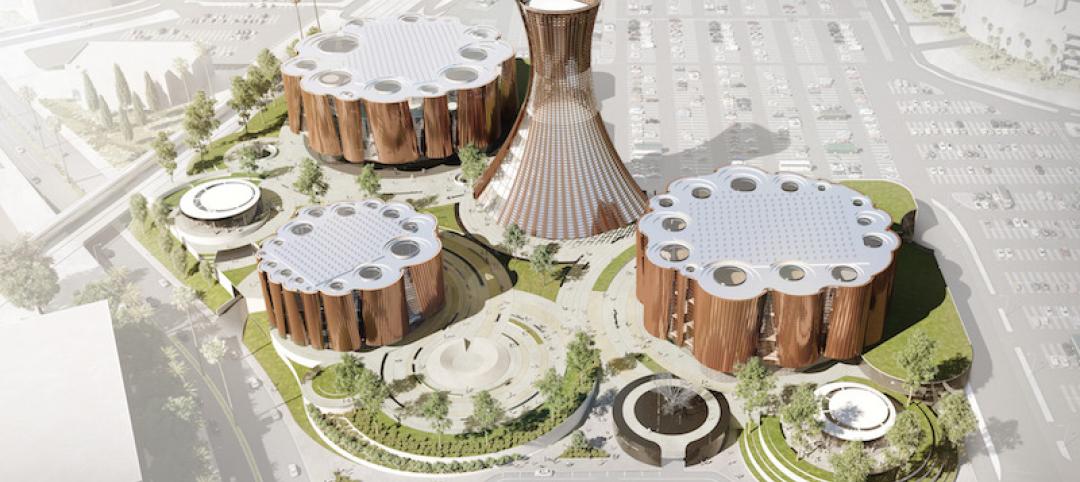
Designed by H. H. Richardson in the 1870s to serve the city's burgeoning Back Bay neighborhood, Trinity Church in the City of Boston would come to represent the essence of the Richardsonian Romanesque style, with its clay tile roof, abundant use of polychromy, rough-faced stone, heavy arches, and massive size. Its 9,500 tons rested on four elephantine granite pyramids, which were set atop 4,000 wooden pilings to prevent the structure from sinking into Back Bay's marshy wetlands.
 |
| PHOTOS: SHAWMUT DESIGN AND CONSTRUCTION |
Some 125 years after its completion, Trinity Church had grown into one of the largest Episcopal congregations in the country, holding 19 services a week and averaging 1,200 worshippers on Sundays. Trinity also drew 100,000 tourists a year, thanks to its status as a National Historic Landmark and one of the AIA's “10 Most Important Buildings in the United States.” Add to that more than 140 community programs that kept meeting rooms bustling 15 hours a day, six days a week, and it was easy to see how Trinity needed room for expansion.
Unfortunately, the passage of time had taken its toll on the building. The church's precious murals, stained glass, and intricate stonework had all been marred by a century-plus of wear. Worse, below ground, fluctuating water tables had damaged the wood pilings, threatening Trinity's very stability.
 |
| PHOTOS: SHAWMUT DESIGN AND CONSTRUCTION |
In 1995, church leaders inaugurated three years of master planning that led to a full-scale restoration and expansion of the church. The plan, like the structure itself, rested on four pillars: 1) return Trinity to its original beauty; 2) expand the church for future generations, 3) update the heating and cooling systems, and 4) keep the church operating during reconstruction.
Heavenly artwork
John La Farge, the father of the American Mural Movement, decorated the interior of Trinity Church with the goal of making parishioners feel as though they were “walking into a painting.” Bringing the church back to its original grandeur required years of historical research, planning, and troubleshooting.
To keep the renovation effort from interrupting religious services and tour groups, general contractor Shawmut Design and Construction and architects/preservationists Goody Clancy installed a series of mobile access towers high above the main sanctuary. Instead of having the usual ungainly wooden beams planted throughout the church, the scaffolding was supported by steel poles planted into the building's stone foundation pyramids.
 |
| Trinity Church occupies a tight, urban site in the heart of Boston’s bustling Copley Square. The Building Team focused on minimizing the impact construction would have on the neighborhood’s offices, hotels, and shops. PHOTO: FARRELL ASSOCIATES CONSTRUCTION PHOTOGRAPHY |
Work focused first on restoring basic structural integrity: repointing masonry, re-roofing, and installing flashing. The team went to great lengths to replicate and restore the original red mortar and replace broken stonework, much of which came from quarries that had vanished long ago. Fortunately, a cache of original stone remnants discovered under the church's west porch allowed the team to complete the repairs in fine fashion.
Moving on to Trinity's artwork, the conservators—including experts from John Canning Painting & Conservation Studios and Gianfranco Pocobene Studio—engaged in a nearly yearlong process that included restoring La Farge's murals and surrounding decoration, bringing back the original brick red background specified by Richardson and La Farge.
Growing God's house
Trinity's biggest concern, however, was lack of space for the growing congregation. Although church leaders had considered expanding into nearby buildings, Trinity's location in a tightly packed urban center limited that option. Instead of looking horizontally, Shawmut, Goody Clancy, and structural engineer LeMessurier Consultants turned their gaze downward to the basement.
Little more than a large crawlspace at the start of renovation, the basement eventually became a 13,000-sf addition, known as the Undercroft. Creating this space required lowering the basement by four feet, which sometimes had to be done by hand to avoid disturbing the sanctuary above or damaging wooden pilings below. Damaged pilings were repaired and capped with metal sections. Engineers also installed pumps to keep the pilings below the water line.
 |
| The Parish House, used for classes, meetings, and rehearsals, sits adjacent to Trinity Church and also was completely renovated and restored. PHOTO: DAVID LAMB ARCHITECTURAL PHOTOGRAPHY |
The excavation left a vast space that exposed the handsome raw granite of Trinity's pyramid footings. The stone was complemented by warm cherry millwork and, inspired by the church's collection of stained glass, a commissioned series of pivoting glass doors that allowed the Undercroft to be portioned up into rooms of various sizes.
Saving more than souls
Technically speaking, the Building Team's most difficult task proved to be updating the HVAC system. Due to its location, the building had no real “back end,” and M/E engineer Cosentini Associates determined that installing an HVAC system in the attic would pose a risk (moisture and vibration) to the works of art below.
The team turned to geothermal energy for a solution. Installing the geothermal pumps meant drilling six wells through soil and bedrock to a depth of 1,500 feet—twice the height of the nearby John Hancock Tower. The job was made doubly difficult by the need to drill without disturbing church services or social activity in adjacent Copley Square. Shawmut solved this problem by erecting noise-reducing wooden structures around the drill system.
All told, the Trinity renovation proved to be one of Boston's most remarkable transformations, earning numerous awards and acclaim from across the nation. Today, with its lusciously restored decoration, its gentle embrace of environmental values, and its firm commitment to future growth, Trinity carries on its founders' vibrant religious and community mission.
Related Stories
Cultural Facilities | Jun 2, 2018
Topping Off: Pikes Peak is getting a new Summit Complex
The 26,000-sf facility will be green, resilient, and emphasize the view rather than the architecture.
Libraries | Jun 1, 2018
New library offers a one-stop shop for what society is craving: hands-on learning
Beyond lending books and DVDs, the Elkridge (Md.) branch library loans household tools like ladders, wheelbarrows, and sewing machines.
Museums | Jun 1, 2018
The new Orange County Museum of Art will be Orange County’s largest center for arts and culture
Morphosis designed the building.
| May 24, 2018
Accelerate Live! talk: Security and the built environment: Insights from an embassy designer
In this 15-minute talk at BD+C’s Accelerate Live! conference (May 10, 2018, Chicago), embassy designer Tom Jacobs explores ways that provide the needed protection while keeping intact the representational and inspirational qualities of a design.
Cultural Facilities | Apr 16, 2018
Best in library design 2018: Six projects earn AIA/ALA library awards
Austin Central Library and the Tulsa City-County Central Library are among the top projects for 2018.
Performing Arts Centers | Feb 20, 2018
Citrus trees inspired the design of this half-billion-dollar performing arts center
SPF:architects designed the complex.
Cultural Facilities | Jan 23, 2018
BIG reveals revised Smithsonian Campus master plan
The original proposal was first unveiled in 2014.
Mixed-Use | Dec 12, 2017
A new live/work neighborhood is about to get under way in Omaha, Neb.
Walkability and recreation will be key features of West Farm.
Cultural Facilities | Nov 2, 2017
Perkins Eastman wins competition to redesign San Francisco’s Harvey Milk Plaza
The Friends of Harvey Milk Plaza unanimously selected the Perkins Eastman entry as the winner.
Museums | Oct 3, 2017
Denmark’s new LEGO experience hub looks like it’s made out of giant LEGO blocks
The 12,000-sm building is part of Billund, Denmark’s goal to become the ‘Capital for Children.’















